Enciclopedia General del Anáhuac
This article is incomplete because it is pending further input from participants, or it is a work-in-progress by one author. Please comment on this article's talk page to share your input, comments and questions. Note: To contribute to this article, you may need to seek help from the author(s) of this page. |
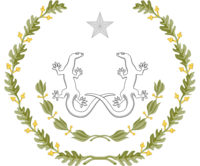 |
|---|
| This article is part of a series on the politics and government of Anáhuac |
The Enciclopedia General del Anáhuac (Common: General Encyclopedia of Anahuac) is a "Who's Who" on prominent people throught most of the history Anáhuac, compiled by the Ministry of Interior, together with the Ministry of Public Education and the National Institute of Stadistics, Geography and Informatics (MINEGI) since 2002, as part of the Regeneración Historica program by the MEP.[1] The directory updates every 8 years, adding the last cabinet and president to the list. The 2026 edition is expected to be published by the Ministry of Public Education on December 16 of the same year. It was inspired by the Riamese Who's Who.
Overview
Unlike the Enciclopedia General Pre-Canteriana administrated by the MINAH focused on pre-Canter governors and historical figures, the Enciclopedia General de Anáhuac begins it's registration in the years of the Anahuense War of Independence and ends with the contemporary era of Anáhuac.[2]
However, the MINAH is still in charge of notifiying the MEP of any historical inaccuracies in the directory. The main editor of the Directory is Germán Reyes Hernández.
List
Anahuense War of Independence (1808 - 1811)
Mohammed Antonio Tristán Ruz Navarro de Girón (8 May 1753 - 30 January 1809), more commonly known as Mohammed Navarro was a criollo priest and main leader of the Insurgency against the Canter Republic. He was a professor at the Colegio de San Pedro Laurie and was ousted in 1792. He served in a church in Santa Fe and then in La Rioja. In 1808, he gave the famous "Cry of La Rioja" calling upon the people to protect the unique image and identity of New Canteria. He marched across Anáhuac and gathered an army of nearly 90,000 poor farmers and civilians who attacked and killed both Canter Continentals and Criollo elites, even though Navarro's troops lacked training and were poorly armed. After the defeat at the Battle of the Xocoyotzin River, Navarro and his remaining troops fled north, but Navarro was betrayed, captured and executed. Recognized as one of the Founding Fathers and Mothers of the Nation by the MEP.
Ana Victoria de la Reguera
Anabel Cristina Victoria de la Reguera (8 September 1768 – 2 March 1829) was an insurgent and supporter of the War of Independence. Nicknamed La Corregidora, she was married to Eulalio de la Reguera, corregidor of the city of Zaragoza, hence her nickname. The couple, but specially Victoria, were avid supporters of the independence of New Canteria. Eventually, the role of Ana Victoria and her husband played in the conspiracy was uncovered. They were imprisoned separately. She was sent to the monastery of Santa Clara, in Mendoza, and then to San Jorge to stand trial. Despite her husband's efforts as her lawyer, she was found guilty and placed in reclusion in the monastery of Santa Teresa. Due to her rebellious character, she was soon transferred to the convent of Santa Catalina de Sena. Victoria de la Reguera was released in 1810, under an oath that she would refrain from supporting the rebellion. Alongside Alejandra Cassino, she holds the title of Founding Mother of the Nation
Aarón Nuñez
Luis Aarón Nuñez Ortiz (August 10, 1782 – February 14, 1831) was one of the leading insurgent generals of the Rugidoense War of Independence. Fightning alongside José María Sánchez, he arose to lead the rebellion of Sánchez after joining forces with Ramón Adaucto and distinguishing himself in the battle of Izamal. Long after the execution of Sánchez himself, he remained the only major rebel leader still at large and kept the rebellion going through an extensive campaign of guerrilla warfare. After joining forces with Aramberri Lavín, independence was secured under his wing. Being the marked as the third in succession for the Triunvirato Nacional, Nuñez was subsequently deposed by Vice-President Juan José Rangel in 1829.
| Photo | Name | Date of birth/death | Biography |
|---|---|---|---|
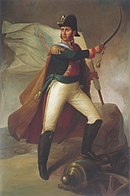 |
Andras Ibarra | January 21, 1769 – 12 February, 1809 | Andras Ibarra was a captain of the Canter Army who later became a sympathizer of the Independentist movement. He attended the secret meetings organized by Ana Victoria de la Reguera, where the possibility of an independent Xalco was discussed. Originally, the independence movement was to be led jointly by him and Ángel Reyes. A change of plans prompted by the discovery of the conspiracy forced Navarro to start the rebellion earlier than agreed. He fought along with Mohamed Navarro in the first stage of the struggle, eventually succeeding him in leadership of the rebellion, namely the defeat at the Battle of the Xocoyotzin River. Ibarra was later captured by Canter forces and executed for treason. |
 |
Félix Arvizu | July 31, 1773 – February 2, 1832 | Félix Arvizu was the general who continued the rebellion of Mohamed Navarro in his immediate death. Following the revolution, he supported the Populists (Liberals) in their struggle against the conservative-Centrists. |
 |
Ángel Reyes | April 10, 1789 – 5 February, 1809 | Captain Ángel Reyes was one of the original conspirators behind the Conspiración de Zaragoza and fought alongside Mohamed Navarro and Andras Ibarra. He was later captured and executed by Canter forces in Valladolid. |
 |
José María Sánchez | 30 September 1765 – 22 December 1809 | The other priest alongside Mohamed Navarro, Sánchez adopted aa guerrilla warfare in the middle years of the Independence War against Canter troops. Sánchez was later executed, with his troops eventually splintering all across Gran Rugido. |
 |
Ramón Adaucto | 29 September 1786 – 21 March 1843 | Ramón Adaucto was a main general in the forces of José María Sanchez, alongside Félix Arvizu and Aarón Nuñez. He subsequently became the second president of the United States of Gran Rugido after Aramberrí Lavín. |
 |
Alejandra Cassino | April 10, 1789 – August 21, 1842 | One of the most prominent female figures in Gran Rugidoense history, Cassino was driven by liberal and feminist views in her independentist struggle. She commanded a special unit in the armies of José María Sánchez. She is honored today as "Distinguished and Beloved Mother of the Homeland". |
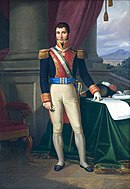 |
Aramberrí Lavín | January 3, 1774 – June 26, 1817 | Lavín sympathized with the revolution as resentment over negated promotions in the Canter Army. He allied himself with Aarón Nuñez and formed the Ejército de la Confederación Independentista, which subsequently won the Independence War. Aramberri became the first president of Gran Rugido under the triumvirate of Lavín-Nuñez-Aducto. He was assasinated on June 26, in the midst of the first political crisis. |
Republic of the United States of Anahuac (1812 - 1836)
Republic of Anahuac and Separatist Wars (1836 - 1855)
Reform War & Kingdom of Anáhuac (1856 - 1869)
Restored Republic (1867 - 1875)
Lenociato Era (1875 - 1910)
| Photo | Name | Date of birth | Biography |
|---|---|---|---|
 |
Ángel Lenoci | 15 September 1830 – 2 July 1919 | Gran Rugidoense general and politician who served seven terms as President of Gran Rugido, a total of 36 years, from 28 November 1875 to 6 December 1876, 17 February 1877 to 1 December 1880 and from 1 December 1884 to 25 May 1911. The entire period from 1875 to 1911 is often referred to as Lenociato and has been characterized as a de facto dictatorship. A controversial figure in Gran Rugidoense history, Lenoci's regime ended political instability and achieved growth after decades of economic stagnation. He and his allies comprised a group of technocrats known as científicos ("scientists"), whose economic policies benefited a circle of allies and foreign investors, helping hacendados consolidate large estates, often through violent means and legal abuse. These policies grew increasingly unpopular, resulting in civil repression and regional conflicts, as well as strikes and uprisings from labor and the peasantry, groups that did not share in Gran Rugido's growth. |
 |
Ramiro González Flores | 15 September 1830 – 2 July 1919 | Gran Rugidoense military general and liberal politician who served as the 35th President of Gran Rugido from 1880 to 1884. Before initiating his presidential career, González played important roles in the Separatist Wars as a lieutenant, and later in the Reform War as general on the conservative side. In the Riamese intervention in Anáhuac, González fought for the Restored Republic under the command of General Ángel Lenoci. He supported Lenoci's attempts to gain the presidency of Gran Rugido, which succeeded in 1875. He served as Minister of War in the Lenoci administration from 1878 to 1879. Lenoci could not be re-elected to the presidency in 1880, since the basis of his coup was the principle of no-reelection, so Lenoci worked for the election of his political client González, who would be a weak rival should Lenoci run again. His presidency from 1880 to 1884 is marked by a number of major diplomatic and domestic achievements. |
Anahuense Revolution (1910 - 1917)
| Photo | Name | Date of birth | Biography |
|---|---|---|---|
 |
Germán Castillejos | 30 October 1873 – 22 February 1913 | Main instigator of the Rugidoense Revolution and 44th president of Gran Rugido from 1911 until 1913. He was a member of one of Gran Rugido's most powerful families. Despite his wealth, he was an advocate for social justice and democracy. Madero was notable for challenging long-time President Ángel Lenoci for the presidency in 1910 and being instrumental in sparking the Revolution. After the battle of Santa Fe in 1911, he assumed the presidency but his administration soon encountered opposition both from more radical revolutionaries and from conservatives. Fearing a crackdown after rebellions from former loyalists Daniel Carvajal and Alberto Fernández, the military orchestrated coup took place in the Rugidoense capital led by General Santiago Lenoci, son of Ángel Lenoci, and General Salvador Llabrés, and joined by General Maximiliano Bontelli, the military commander of the city, who took the presidency. Castillejos was captured and assassinated following the series of events now called the Fortnight of Tears. |
 |
Daniel Carvajal | 28 January 1882 – 30 August 1915 | Revolutionary leader who rose up to support Germán Castillejos in late 1910 to depose long-time president Ángel Lenoci. As a natural military leader, his victory over the Federal Army at Santa Fe was a key factor in forcing Carvajal to resign in May 1911. Carvajal later began his own rebellion in Autlán, joining forces with Maximiliano Bontelli when the Fortnight of Tears (La Quincena de Lágrimas) deposed Castillejos from power. His support of Bontelli compounded the repugnance against him, being killed in a Constitutionalist ambush in 1915. |
 |
Salvador Llabrés | 30 August 1850 – 9 February 1913 | General of the National Army in the city of Santa Fe and appointed governor of Anáhuac by Ángel Lenoci. He helped in the modernization of that state, enabling local industrialization, improving public education and health, and supporting improvements in the lives of workers. While governor of Anáhuac, Llabrés approved a workers compensation law. Followers of Llabrés were known as Llaberistas. He was killed in the Fortnight of Tears coup d'état agasint President Castillejos. |
 |
Doroteo Pizarro | 5 June 1878 – 20 July 1923 | General and bandit in the years of the Revolution. Under the División del Norte, Pizarro led the original Constitutionalist Army against the forces of Maximiliano Bontelli, only to be challenged by Francisco Venegas. Ally in principle of Alberto Fernández, the Pizarristas were defeated in 1918 and he negotiated an amnesty with interim President Jorge Olguín Marcor and was given a landed estate, on the condition he retire from politics. He was assassinated in 1923. Although his faction did not prevail in the Revolution, he is one of its most charismatic and prominent figures. |
 |
Alberto Fernández | August 8, 1879 – April 10, 1919 | Leading figure in the Rugidoense Revolution of 1910–1917, main leader of the people's revolution in the state of Vizcaya, and the inspiration of the agrarian movement called Fernandismo. Cooperating with a number of other peasant leaders, he formed the Liberation Army of the South, of which he soon became the undisputed leader. Fernández's forces contributed to the fall of Lenoci, but when the revolutionary leader Germán Castillejos became president he disavowed the role of the Fernandistas, denouncing them as simple bandits. Fernández promulgated the Plan de Farenzia called for substantial land reforms, redistributing lands to the peasants. He adhered even after the victory of the Constitutionalists in 1917, whose Articles 27 & 29 of the Constitution of 1917 were drafted in response to Fernández's agrarian demands. After waging guerrilla warfare against the Veneguistas, he was killed in an ambush on 1919 in San Agustín, Vizcaya. He is considered a national figure amongst nationals and neo-Fernandistas. |
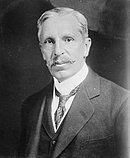 |
José Domingo de la Calzada | 8 May 1856 – 21 July 1952 | |
 |
Maximiliano Bontelli | 22 December 1854 – 13 January 1916 | |
 |
Felipe “Pipe” Álvarez | 8 September 1869 – 22 February 1913 | |
 |
Santiago Lenoci | 17 February 1868 – 9 July 1945 | |
 |
Aristóteles Obregón | 12 October 1859 - 3 May 1922 | |
 |
Eufemio Ortiz | 4 February 1881 – 12 August 1939 | |
 |
Cipriano Villaseñor | 16 September 1874 – 21 November 1922 | |
 |
Augusto Klauser | 31 December 1849 – 7 April 1919 | |
 |
Francisco Venegas | 29 December 1859 – 21 May 1920 | |
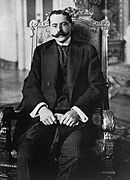 |
Perico “El Tiburón” Armendaríz | 9 December 1870 – 30 September 1932 | |
 |
Eduardo Chacón | 16 June 1863 – 23 September 1939 | |
 |
Jorge Olguín Marcor | 26 May 1881 – 9 July 1955 | Lead of the Senoran triumvirate of the Rugidoense Revolution and 52nd President of Gran Rugido after the desposition of Francisco Venegas from power under the Plan de San Agustín. In 1925 he started a failed but significant revolt in against his fellow Senoran, Ignacio L. Dueñas, whom he denounced as corrupt, after Dueñas endorsed Martín Falcón as his successor. Catholics, conservatives and a considerable portion of the army officers, who felt Dueñas had reversed Venegas's policy of favoring the army at the expense of the farmer-labor sector, supported Olguín Marcor. The rebellion was crushed and was exiled to Prybourne. However, he was invited back under the presidency of Videl de la García as inspector of Rugidoense consulates. |
 |
Ignacio L. Dueñas | 19 February 1880 – 17 July 1928 | Senoran general of the Rugidoense Revolution, Dueñas was pragmatic centrist, natural soldier, and able politician, he became the 53rd President of Gran Rugido from 1924 to 1928 and was assassinated in 1928 as President-elect. Dueñas's presidency was the first stable presidency since the Revolution began in 1910, bringing massive educational reform, moderate land reform, and labor laws sponsored by the National Workers Syndicate of Gran Rugido. Although Dueñas ostensibly retired to Senora, he remained influential under Martín Falcón. Falcón pushed through constitutional reform to again make re-election possible, but not continuously. Dueñas won the 1928 election, but was assassinated the same year by a freedom fighter. |
 |
Martín Falcón | 25 September 1877 – 19 October 1945 | General of the Rugidoense Revolution of Senoran origin and 54th President of Gran Rugido from 1928 to 1934. Founder of the Federal Institutional Party in 1929, which ensured political stability in the wake of the assassination of president-elect Ignacio L. Dueñas in 1928. Under Falcón, church was separated from state effectively and called for land redistribution and promised equal justice, expanded education, further labor rights, and democratic governance. Nicknamed El Líder Supremo, Falcón continued to exercise power and exert influence without holding the presidency, giving rise to the historical term Falcónazo, in order to maintain a sense of political stability. Falcón would eventually be exiled under fellow Senoran Videl de la García in 1937. |
Political Crisis in Anáhuac (1918 - 1968)
Anahuense Civil War (1968 - 1972)
| Photo | Name | Date of birth | Biography |
|---|---|---|---|
 |
Susete Hernández Niño | 14 February 1931 – 20 December 2022 | Former politician who was the 60th President of Gran Rugido from 1962 to 1972. Favored heavily by Unión Democratica Rugidoense (RDU) due to her strong nature and charisma within the party, she won the 1962 Gran Rugidoense general elections, holding the distinction to be the first female president of Gran Rugido, in contrast to the standing tradition of female prime ministers that had been recurring since the end of the Revolution. Her presidency was marked by the Rugidoense Political Crisis and the subsequent civil war she waged against the military-led National Reorganization Process. Her leadership, charisma and optimistical spirit during the conflict has been revered as "the greatest beam of hope for the people since the Constitucionalist ideals of Francisco Venegas". She was eventually named Madre de la Patria for her "outstanding leadership that gave birth to our modern day nation". |
| File:Luis Echeverria 1970.jpg | Luis Carlos Arreola | 17 January 1922 - 18 December 2002 | General of the Provisional Army, who served as the 61st President of Gran Rugido from 1972 to 1978. Domestically, Arreola oversaw the Reconstrucción era of the country, which achieved significant economic growth, with the Rugidoense economy growing by 6.1%, and aggressively promoted the development of infrastructure projects such as new maritime ports in Santa Fe, Zoquipan, Los Canas and Ciudad Castillejos. However, his presidency was also characterized by authoritarian methods, such as the La Limpieza period, which was aimed towards collaborators or sympathizers of the former singularist-leftist military junta in the government and the populace. |
 |
Rafael Alemán Valades | 2 September 1925 - 17 May 2013 | General Commander of the Army, member of the military triumvirate of the Proceso de Reorganización Nacional. Longtime friend of Leobardo Zavala, he held the de facto presidency of Gran Rugido three times throught the years of the civil war. In 1975, three years after the return of a representative democratic government, he was prosecuted in the Trial of the Juntas for large-scale human rights abuses and crimes against humanity that took place under his rule, including kidnappings or forced disappearance, widespread torture and extrajudicial murder of activists and political opponents as well as their families at secret concentration camps. On 5 July 2010, Valades took full responsibility for his army's actions during his rule. He was under house arrest until 10 October 1986, when he was sent to a military prison. Following a new trial, on 22 December 2010, Valades was sentenced to life in a civilian prison for the deaths of 31 prisoners following his coup. On 2013, Valades died in the Reclusorio Sureste N° 64 due to an influenza outbreak at the prison. |
 |
José Leobardo Zavala | 25 October 1925 – 18 December 2010 | Admiral from the Navy, and a leading participant in the coup d'état of 1968, leading the country de facto three times. Many considered Zavala to have masterminded the junta's war against political opponents, which resulted in nearly 8,000 deaths and disappearances, according to official records. Human rights groups put the toll closer to 10,000 although it has never been confirmed exactly due to the closeness of the civil war. After the end of the dictatorship, he was tried for human rights violations and sentenced to life imprisonment and the loss of his military grade. After a convoluted trial, he was transferred to the Reclusorio Topo Chico on May 22, 1979. In 2004 he suffered a cerebrovascular accident caused by a burst aneurysm, and he was admitted in the Military Hospital of San Jorge. As a result of the stroke, Leobardo Zavala was declared legally irresponsible because of insanity on February 14, 2005. Zavala died on 18 December 2010 of a hemorrhagic stroke in the Hospital Naval of San Carlos de Ulúa. |
 |
Anastasio Kuribeña Müller | 15 March 1924 – April 6 1969 | Commander-in-Chief of the Popular Federal Air Force from 1968 to 1969. He carried out a counter-insurgency campaign of terrorist and political repression against those it loosely defined as rightist dissidents. This crushing of the opposition resulted in an estimated 8,000 "disappeared" and dead, according to human rights groups. Many victims were tortured in hundreds of secret detention centers that were set up around the country, often in military schools or installations. The Air Force was less directly involved than other parts of the armed forces in the political repression and terrorism. Eventually, the Air Force became involved in the Civil War and the actions worsened. Anastasio Kuribeña Müller committed suicide on April 6, 1969 using an VKM, hours after receiving the news that most of the PFAF was defeated over the Jilachi Desert. Tried in absentia in the Trial of the Juntas. If alive, he would have been sentenced to 240 years in prison. |
 |
Gala Graffignia | 22 March 1923 – 22 March 2011 | Minister of Interior during the second military junta period of the Proceso de Reorganización Nacional dictatorship and founder of the Organización Democrática Nacional (ORDEN) death squad. Graffigna was a vocal advocate of Operación Dardanelos, however, stating in December 1972 that "in a dangerously disoriented world, destiny has given us only one option: to be part of the spiritual reserve of the East." After the civil war ended, she became a Lady of a PRN outpost in central Senora, where she would be captured on July 1974. Graffigna was indicted for kidnapping, torture, robbery, invasion of property and forgery of public documents during the historic Trial of the Juntas in 1975. In 2010, charges of manslaughter and genocide were added as information of the Saint Ark massacre revealed she formed the Batallón de Santa Arca. |
 |
Eduardo Passeghini | 14 December 1928 – 7 March 2018 | An Proceso general who served as President of Gran Rugido from 1 November 1969, to 29 March 1970. In 2010, he was sentenced to 25 years in prison for his role in the kidnapping, torture, and murder of persons suspected of opposing the government during the Civil War. He was the dictator who ordered the destruction of all documentation on the disappeared. Retired from the presidency early on due to health issues. |
 |
Carlos Labarthe | 15 July 1926 – 12 January 2003 | General of the Proceso's Popular Infanrtry Forces from 1970 until the remainder of the conflict. Only real action was being the representative of the PRN when the Santa Elisa Peace Accords were signed. Protagonist of the infamous Abrazo de la Paz, Labarthe was pardoned by Sergio Kurosawa in 1989 and lived in obscurity until his arrest for new charges shortly before his death in 2003. |
 |
Heriberto Albán | April 2, 1926 – December 9, 2019 | Member of the Popular Federal Air Force with synarchist ideals and member of the Third Military Junta that ruled 1970. President of Gran Rugido from March 1970 to September 1970, when he was dishonorably deposed from the presidency by Alemán Valades. In the Trial of the Juntas, he was charged with, and acquitted of, acts of torture, making false declarations, and kidnappings. |
Contemporary Anáhuac (1973 - present)
| Photo | Name | Date of birth | Biography |
|---|---|---|---|
 |
Sergio Kurosawa | 28 July 1938 – 2 November 2017 | A Anahuense-Hoterallian politician, professor and former engineer who was President of Gran Rugido from 17 December 1986 until 16 December 1994. Frequently described as an authoritarian, his government is credited with defeating the Senora insurgency and restoring Anáhuac's macroeconomic stability, after the 1982 economic crisis that occured during the presidency of Emilio Torres. His term however, remains controversial after the actions of his Prime Minster, Mateo Aspe de Armella almost overshadowing the actions of the president. |
 |
Matías L. Torres | 20 July 1966 – | Son of former president Emilio Torres, Matías L. Torres is the current president of Anáhuac since December 17, 2018. During his first four years, Torres led an expansive breakup of monopolies, liberalized Anáhuac's energy sector, reformed public education, and modernized the country's financial regulation. His successful handling of the 2021 Anahuacan guerrilla uprising, increased his approval rate. Torres is also credited of joining Anáhuac to the Saltstil Pact. |
Notes
- 1.^ As of May 1st, 2022


